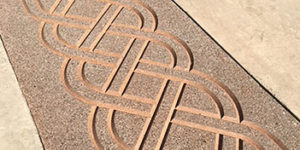If I were still a contractor I would take “preexisting” projects over new projects every day of the week and twice on Sunday.
We have seen more new unfinished surfaces totaled beyond the budget’s ability to recover than we have seen hopeless pre-used slabs. I have witnessed schools and other complexes that spec polished concrete fail to understand the need to manage the slab up to the point that the polisher begins work. They find that there is more repair needed on the new slab than they can possibly absorb in the project budget.
Many times, these challenges get put on the polishing contractor with threats or promises from the GC. The polisher then has to weigh a huge risk factor — that he or she was not considering when the original bid was submitted — to keep the job to which they have dedicated the near future of their business.
Older slabs, in contrast, are normally better understood by the design team even when damages are present. The customer is also more willing to pay a fair price for the project due to the condition of the slab.
With that in mind, let’s look into what makes for profitable preexisting projects. You may pick up on the theme that communication is the key to ensuring profitable and happy outcomes on preexisting floors. If this simple process is followed, I believe that you will find as I have in my 15 years of polishing experience that preexisting floors can be the best business your company can do.
Pre-bid evaluation
This function is paramount to setting up the preexisting project for success, as everything else will derive from the discovery process completed and communicated during this function.
Take the time to evaluate the entire surface, never assuming that an evaluation of 50 percent of the surface will be representative of the other 50 percent.
Make sure you are in the right frame of mind to be looking for the details. If you need to have conversations with the building management prior to or after the evaluation to have your full mind involved in the discovery process, politely excuse yourself from the customer to complete this function. I have seen people travel hundreds of miles to meet a customer and evaluate a preexisting floor surface, only to come back with glowing reports about a great meeting with the customer, but no idea of the scope or what repairs were necessary and no pictures or site maps or filled-out evaluation forms. They spent all their time talking to the customer about opportunities and no time doing the discovery. This is a recipe for disaster.
Make sure you can see the floor. If it is too dark for you to read something lying on the floor, it is too dark for you to be certain that you are seeing everything you need to be seeing. Get light.
Get good project software that has the capability built in for doing these types of evaluations, including detailed floor-plan templates that can be easily populated with dimensions and locations of specific concrete repairs, embedded drains, slab variations, joint pattern layouts and dimensions of joints. If you are a smaller operation or are just starting out, make your own evaluation form or send your sales reps to training institutes that provide boilerplate forms. Either way, a floor drawing should be included in each evaluation packet, at least with manual drawings on engineering paper.
Count the holes and damaged spots. If there are too many for you to count, imagine how much work it is going to take for your team to correct them. If it is a huge area and you determine that a uniform solution such as grout-coating the area is the fix, make sure to get the dimensions of the areas to be grout-coated and the approximate depth and width of the surface spalls and holes to be filled with the grout material.
Take the time after your evaluation to show the customer the areas of concern. Don’t be afraid to scare off the sale. If the introduction of the areas of concern to the customer — areas that are still going to show some signs of repair after completion or areas that are going to cost more than the base bid — scares the customer away, you will save a lot of time and money getting that out of the way at this stage in the game instead of waiting until you are already vested in the project to have that conversation.
The demo and setting expectations
Setting expectations is an equally important function in the preexisting-slab evaluation process. It is natural for sales reps to try to avoid this seemingly confrontational step due to the optimistic and relaxed environment of the relationship with the prospective customer up to that point. It is much easier to leave the customer on a high note, having avoided any negative conversations, and then pass the buck to the project manager who shows up on-site and tries to clean up the mess by attempting to set the customers’ expectations after the fact of the signed contract. I recommend that you replace any sales reps that you find creating this kind of problem, as the damage to the reputation of your company can be irreparable.
Look the customer in the eyes and explain the limitations of your product. It can help to have multiple offerings available from your company or to give comparisons to other options on the market so the customer doesn’t feel like he or she needs to shop around.
Sell a demo first. If you have a serious customer who has money allotted to make improvements to their slab, it should not be a difficult thing to sell a paid demo to them. Yes, I said a paid demo. If you give the demo away, you have set an unrealistic expectation that can begin an unhealthy relationship right from the start. If you would like to credit some of the cost back to the customer for the demo once the contract is signed for the entire project, that is fine, as the cost of the demo can be recovered in the price of the job.
Pick a place for the demo that is representative of the poorer areas of the slab. If you put a great-looking demo in the best area of the slab, the expectations of the customer will be that the entire slab will be equal to that demo. This can also be held against you in court if there is a claim that your company intended to purposely mislead the customer into believing that your services could make the entire floor look like that spot.
Show the customers the imperfections in the demo. This will also show you the customers’ expectations better than anything else would.
Leave the demo untouched until the end of the entire project.
The quote and the job
Clearly define the intended scope of work in both your quote, your pre-construction meeting agenda and in your contract proposal.
Being clear with the customer about what you are bidding on is essential, as it documents the level of understanding at a point in time. This can be very important later in the project if unexpected circumstances arise. If you are uncertain about the condition of the slab under a material that you are contracted to remove as part of the process, make that clear in the bid and the contract, and include contingency prices for additional steps or time and materials rates that include your hourly rate in the event that unforeseen challenges arise.
Bring the customer in early on any unforeseen challenges you encounter, and try to let them see for themselves what you are capable of doing to improve or rectify the challenges, as well as how much labor and materials it is requiring from your company to do so. A customer that is left in the dark and then hit with a change order is not as understanding as a customer that meets you on-site to examine a challenge and works through it with you in a small area with your crew.
Get progressive signoffs from the customer as you turn sections of the slab over to be put into use or to other trades. This will help eliminate any disputes that may arise over damages that may occur after your floor system has been installed but before the entire building is complete.
Get the customer to meet you the day you plan to finish the project to walk the entire slab and sign off for acceptance. This is the time to push the customer a little, as this is essential to getting payment in a timely manner and freeing your company from responsibility for future damage to the polished surface.
After you’re done
Give your customer an ongoing maintenance plan. If you want the customer to stay happy and bring you more business in the future, don’t just walk away and hope for the best.
Leave the customer with a care package. This will include an instruction sheet with material order forms attached for the manufacturer that you are recommending for floor-cleaning materials and support.
Leave the customer a starter kit. This can include a sample kit of soap, degreaser, sweeping compound, and a new set of brushes for their scrubber to replace the stiff, ragged ones they have been using up to that point.
Replace any stiff-bristle brushes or coarse pads before you leave with the proper maintenance pads for the polished surface.
Follow up with your customer periodically to support them in their maintenance process and insure that their floor is staying healthy.















